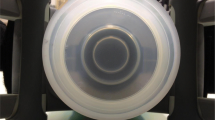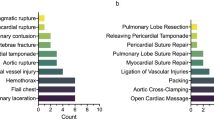Abstract
The aim of this autopsy study was to investigate chest-compression associated injuries to the trunk in out-of-hospital and in-hospital non-traumatic cardiac arrest patients treated with automated external chest compression devices (ACCD; all with LUCAS II devices) versus exclusive manual chest compressions (mCC). In this retrospective single-center study, all forensic autopsies between 2011 and 2017 were included. Injuries following cardiopulmonary resuscitation (CPR) in patients treated with mCC or ACCD were investigated and statistically compared using a bivariate logistic regression. In the seven-year period with 4433 autopsies, 614 were analyzed following CPR (mCC vs. ACCD: n = 501 vs. n = 113). The presence of any type of trunk injury was correlated with longer resuscitation intervals (30 ± 15 vs. 44 ± 25 min, p < 0.05). In comparison with mCC, treatment with ACCD led to more frequent skin emphysema (5 vs 0%, p = 0.012), pneumothorax (6 vs. 1%, p = 0.008), lung lesions (19 vs. 4%, p = 0.008), hemopericardium (3 vs 1%, p = 0.025) and liver lesions (10 vs. 1%, p = 0.001), all irrespective of confounding aspects. Higher age and longer CPR durations statistically influenced frequency of sternal and rib fractures (p < 0.001). The mean number of fractured ribs did not vary significantly between the groups (6 ± 3 vs. 7 ± 2, p = 0.09). In this cohort with unsuccessful CPR, chest compression-related injuries were more frequent following ACCD application than in the mCC group, but with only minutely increased odds ratios. The severity of injuries did not differ between the groups, and no iatrogenic injury was declared by the forensic pathologist as being fatal. In the clinical routine after successful return of spontaneous circulation a computed tomography scan for CPR-associated injuries is recommended as soon as possible.





Similar content being viewed by others
References
Kouwenhoven WB, Jude JR, Knickerbocker GG. Closed-chest cardiac massage. JAMA. 1960;173:1064–7.
Stiell IG, Brown SP, Christenson J, Cheskes S, Nichol G, Powell J, et al. What is the role of chest compression depth during out-of-hospital cardiac arrest resuscitation? Crit Care Med. 2012;40:1192–8.
Perkins GD, Jacobs IG, Nadkarni VM, Berg RA, Bhanji F, Bossaert LL, et al. Cardiac arrest and cardiopulmonary resuscitation outcome reports: update of the Utstein Resuscitation Registry Templates for Out-of-Hospital Cardiac Arrest: a statement for healthcare professionals from a task force of the International Liaison Committee on Resuscitation (American Heart Association, European Resuscitation Council, Australian and New Zealand Council on Resuscitation, Heart and Stroke Foundation of Canada, InterAmerican Heart Foundation, Resuscitation Council of Southern Africa, Resuscitation Council of Asia); and the American Heart Association Emergency Cardiovascular Care Committee and the Council on Cardiopulmonary, Critical Care, Perioperative and Resuscitation. Circulation. 2015;132:1286–300.
Gates S, Lall R, Quinn T, Deakin CD, Cooke MW, Horton J, et al. Prehospital randomised assessment of a mechanical compression device in out-of-hospital cardiac arrest (PARAMEDIC): a pragmatic, cluster randomised trial and economic evaluation. Health Technol Assess. 2017;21:1–176.
Soar J, Nolan JP, Böttiger BW, Perkins GD, Lott C, Carli P, et al. European resuscitation council guidelines for resuscitation 2015: section 3. Adult advanced life support. Resuscitation. 2015;95:100–47.
Truhlar A, Deakin CD, Soar J, Khalifa GE, Alfonzo A, Bierens JJ, et al. European resuscitation council guidelines for resuscitation 2015: section 4. Cardiac arrest in special circumstances. Resuscitation. 2015;95:148–201.
Ondruschka B, Baier C, Hartwig T, Gräwert S, Böhm L, Dreßler J, et al. Guideline adherence of frustrating cardiopulmonary resuscitation by automated external chest compression devices. Notarzt. 2018. https://doi.org/10.1055/a-0669-9207.
Marti J, Hulme C, Ferreira Z, Nikolova S, Lall R, Kaye C, et al. The cost-effectiveness of a mechanical compression device in out-of-hospital cardiac arrest. Resuscitation. 2017;117:1–7.
Newberry R, Redman T, Ross E, Ely R, Saidler C, Arana A. No benefit in neurologic outcomes of survivors of out-of-hospital cardiac arrest with mechanical compression device. Prehosp Emerg Care. 2018;22:338–44.
Buckler DG, Burke RV, Naim MY, MacPherson A, Bradley RN, Abella BS, et al. Association of mechanical cardiopulmonary resuscitation device use with cardiac arrest outcomes: a population-based study using the CARES registry (Cardiac Arrest Registry to Enhance Survival). Circulation. 2016;134:2131–3.
Ji C, Lall R, Quinn T, Kaye C, Haywood K, Horton J, et al. Post-admission outcomes of participants in the PARAMEDIC trial: a cluster randomised trial of mechanical or manual chest compressions. Resuscitation. 2017;118:82–8.
Pinto DC, Haden-Pinneri K, Love JC. Manual and automated cardiopulmonary resuscitation (CPR): a comparison of associated injury patterns. J Forensic Sci. 2013;58:904–9.
Olds K, Byard RW, Langlois NE. Injuries associated with resuscitation – an overview. J Forensic Legal Med. 2015;33:39–43.
Smekal D, Johansson J, Huzevka T, Rubertsson S. No difference in autopsy detected injuries in cardiac arrest patients treated with manual chest compressions compared with mechanical compressions with the LUCAS device – a pilot study. Resuscitation. 2009;80:1104–7.
Smekal D, Lindgren E, Sanderl H, Johansson J, Rubertsson S. CPR-related injuries after manual or mechanical chest compressions with the LUCAS™ device: a multicenter study of victims after unsuccessful resuscitation. Resuscitation. 2014;85:1708–12.
Lardi C, Egger C, Larribau R, Niquille M, Mangin P, Fracasso T. Traumatic injuries after mechanical cardiopulmonary resuscitation (LUCAS™2): a forensic autopsy study. Int J Legal Med. 2015;129:1035–42.
Koster RW, Beenen LF, van der Boom EB, Spijkerboer AM, Tepaske R, van der Wal AC, et al. Safety of mechanical chest compression devices AutoPulse and LUCAS in cardiac arrest: a randomized clinical trial for non-inferiority. Eur Heart J. 2017;38:4006–13.
Kolopp M, Franchi A, Grafiadis P, Martrille L. Cardiothoracic injuries after CardioPump CPR: a report of two cases and review of the literature. Int J Legal Med. 2018;132:771–4.
Milling L, Leth PM, Astrup BS. Life-threatening and suspicious lesions caused by mechanical cardiopulmonary resuscitation. Am J Forensic Med Pathol. 2017;38:219–22.
Ondruschka B, Hartwig T, Gries A, Hädrich C, Dreßler J, Bernhard M. Pericardial laceration after using an automated mechanical chest compression device. Notfall Rettungsmed. 2017;20:424–9.
Ondruschka B, Baier C, Siekmeyer M, Buschmann C, Dreßler J, Bernhard M. Cardiopulmonary-resuscitation-associated injuries in still−/newborns, infants and toddlers in a German forensic collective. Forensic Sci Int. 2017;279:235–40.
German Society of Legal Medicine. S1 guideline ‘Forensic autopsy’. 2017. http://www.awmf.org/uploads/tx_szleitlinien/054-001l_S1_Die-rechtsmedizinische_Leichenoeffnung_2018-02.pdf. Accessed 09 July 2018.
Gates S, Quinn T, Deakin CD, Blair L, Couper K, Perkins GD. Mechanical chest compression for out of hospital cardiac arrest: systematic review and meta-analysis. Resuscitation. 2015;94:91–7.
Buschmann C, Schulz T, Toskos M, Kleber C. Emergency medicine techniques and the forensic autopsy. Forensic Sci Med Pathol. 2013;9:48–67.
Fanton L, David JS, Gueugniaud PY, Malicier D. Forensic aspects of automated chest compression. Resuscitation. 2008;77:273–4.
Yamaguchi R, Makino Y, Chiba F, Torimitsu S, Yajima D, Inokuchi G, et al. Frequency and influencing factors of cardiopulmonary resuscitation-related injuries during implementation of the American Heart Association 2010 Guidelines: a retrospective study based on autopsy and postmortem computed tomography. Int J Legal Med. 2017;131:1655–63.
Truhlar A, Hejna P, Zabka L, Zatopkova L, Cerny V. Injuries caused by the autopulse and LUCAS II resuscitation systems compared to manual chest compressions. Resuscitation. 2010;81:S62.
Koga Y, Fujita M, Yagi T, Nakahara T, Miyauchi T, Kaneda K. Effects of mechanical chest compression device with a load-distributing band on post-resuscitation injuries identified by post-mortem computed tomography. Resuscitation. 2015;96:226–31.
Rößler L, Dümpelmann D, Tsokos M. “Simon’s bleedings“ without a hanging situation. Rechtsmedizin. 2018;28:298–300.
Rubertsson S, Smekal D, Huzevka T, Johansson J. Mechanical chest compressions with the LUCAS device does not increase the incidence of injuries in cardiac arrest victims. Circulation. 2007;116:II_930.
Agdal N, Jorgensen TG. Penetrating laceration of the pericardium and myocardium and myocardial rupture following closed-chest cardiac massage. Acta Med Scand. 1973;194:477–9.
Klintschar M, Darok M, Radner H. Massive injury to the heart after attempted active compression-decompression cardiopulmonary resuscitation. Int J Legal Med. 1998;111:93–6.
Krischer JP, Fine EG, Davis JH, Nagel EL. Complications of cardiac resuscitation. Chest. 1987;92:287–91.
Boland LL, Satterlee PA, Hokanson JS, Strauss CE, Yost D. Chest compression injuries detected via routine post-arrest care in patients who survive to admission after out-of-hospital cardiac arrest. Prehosp Emerg Care. 2015;19:23–30.
Baubin M, Rabl W, Pfeiffer KF, Benzer A, Gilly H. Chest injuries after active compression-decompression cardiopulmonary resuscitation (ACD-CPR) in cadavers. Resuscitation. 1999;43:9–15.
Buschmann C, Schulz F. Delayed pericardial tamponade after successful resuscitation. Resuscitation. 2009;80:1328–9.
Buschmann C, Tsokos M. Frequent and rare complications of resuscitation attempts. Intensive Care Med. 2009;35:397–404.
Treffer D, Monschau S, Helm M, Weißleder A. Mechanische thoraxkompressions-geräte. Notfallmedizin Up2date. 2018;13:125–30.
Englund E, Silfverstolpe J, Halvarsson B, Löfberg H, Walther C. Injuries after cardiopulmonary resuscitation: a comparison between LUCAS mechanical CPR and standard CPR. Resuscitation. 2008;77:S13–4.
Menzies D, Barton D, Darcy C, Nolan N. Does the LUCAS device increase trauma during CPR? Resuscitation. 2008;77:S13.
Tranberg T, Lassen JF, Kaltoft AK, Hansen TM, Stengaard C, Knudsen L, et al. Quality of cardiopulmonary resusciation in out-of-hospital cardiac arrest before and after introduction of a mechanical chest compression device, LUCAS-2; a prospective, observational study. Scand J Trauma Resusc Emerg Med. 2015;23:37.
Acknowledgments
The authors would like to thank Miss Lina Woydt for providing the anatomic sketch and Miss Aqeeda Singh for proofreading the paper as a native speaker.
Author information
Authors and Affiliations
Corresponding author
Ethics declarations
Conflict of interest
The authors declare that they have no conflict of interest.
Ethical approval
The study was approved by the ethics committee of the Medical Faculty of the University of Leipzig, Germany (code: 104/17-ek).
Informed consent
Informed consent was waived due to the retrospective nature of the study.
Electronic supplementary material
Supplemental Fig. 1
Overview of the annual distribution of forensic autopsy cases at the Institute of Legal Medicine (University of Leipzig, Germany) with unsuccessful cardiopulmonary resuscitation (CPR) subdivided in annual numbers of manual chest compression (mCC) and automated chest compression device (ACCD) recorded in this study. All ACCD cases used a LUCAS II device. (JPEG 35 kb)
Rights and permissions
About this article
Cite this article
Ondruschka, B., Baier, C., Bayer, R. et al. Chest compression-associated injuries in cardiac arrest patients treated with manual chest compressions versus automated chest compression devices (LUCAS II) – a forensic autopsy-based comparison. Forensic Sci Med Pathol 14, 515–525 (2018). https://doi.org/10.1007/s12024-018-0024-5
Accepted:
Published:
Issue Date:
DOI: https://doi.org/10.1007/s12024-018-0024-5




